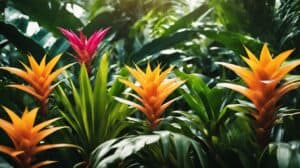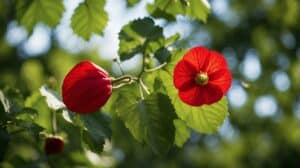Buddleja Davidii, commonly known as butterfly bush, is a popular ornamental plant that is native to China.
It is well-known for its ability to attract butterflies, making it a favorite among gardeners who want to create a butterfly-friendly garden.
This plant is a deciduous shrub that can grow up to 10 feet tall and 15 feet wide.
It produces long, narrow leaves that are gray-green in color and fragrant, cone-shaped flowers that range in color from purple to pink to white.

Butterfly bush is a low-maintenance plant that is easy to grow and care for.
It prefers full sun and well-drained soil, but it can also tolerate partial shade and poor soil conditions.
It blooms from mid-summer to early fall and attracts a wide variety of butterflies, including monarchs, swallowtails, and painted ladies.
In addition to its ornamental value, butterfly bush also has medicinal properties and has been used in traditional Chinese medicine to treat a variety of ailments.
Understanding Buddleja Davidii
Origins and Characteristics
Buddleja Davidii, also known as the butterfly bush, is native to China and was introduced to Europe in the late 1800s.
It is a deciduous shrub that can grow up to 10 feet tall and 15 feet wide. The leaves are lance-shaped and can be up to 8 inches long.
The flowers are fragrant and come in a variety of colors, including pink, purple, white, and red.
The butterfly bush gets its name from the fact that it is a favorite of butterflies and other pollinators.
Growth Requirements
Buddleja Davidii is a hardy shrub that can grow in a variety of soil types, from sandy to clay.
It prefers well-drained soil and full sun, but can also tolerate partial shade. The shrub is drought-tolerant and can survive in areas with low rainfall.
Buddleja Davidii is also relatively low-maintenance and does not require much pruning.
However, pruning can help to shape the shrub and encourage more blooms.
Varieties and Cultivars
There are many varieties and cultivars of Buddleja Davidii available, each with its own unique characteristics. Some popular varieties include:
- ‘Black Knight’: This variety has dark purple flowers and can grow up to 8 feet tall.
- ‘Pink Delight’: This variety has pink flowers and can grow up to 6 feet tall.
- ‘Royal Red’: This variety has deep red flowers and can grow up to 10 feet tall.
There are also dwarf varieties available, such as ‘Blue Chip’ and ‘Nanho Blue’, which only grow to be 2-3 feet tall.
These varieties are perfect for smaller gardens or containers.
Overall, Buddleja Davidii is a beautiful and easy-to-grow shrub that can attract a variety of pollinators to your garden.
With its colorful blooms and fragrant flowers, it is a great addition to any landscape.
Cultivation and Care

Planting Tips
Buddleja Davidii is a hardy plant that can grow in a wide range of soil types and conditions. However, it prefers well-drained soil and full sun exposure.
When planting, make sure to dig a hole that is twice as wide as the root ball and just as deep.
Mix some compost or organic matter into the soil to improve drainage and fertility.
Water the plant well after planting and keep the soil moist for the first few weeks until the plant becomes established.
Pruning and Maintenance
To keep the Butterfly Bush healthy and blooming, regular pruning is necessary. Prune the plant in late winter or early spring before new growth begins.
Remove any dead, diseased, or damaged wood and cut back the remaining branches to a height of 12 to 18 inches. This will encourage new growth and more flowers.
Deadheading spent blooms will also promote more blooms throughout the growing season.
Pest and Disease Management
Buddleja Davidii is generally a low-maintenance plant that is not prone to serious pest or disease problems.
However, it may be susceptible to spider mites, aphids, and powdery mildew in humid conditions.
To prevent these problems, keep the plant well-watered and avoid overhead watering.
If necessary, treat with insecticidal soap or neem oil for pests and fungicide for powdery mildew.
Overall, Buddleja Davidii is an easy-to-grow plant that can add color and beauty to any garden while attracting butterflies and other pollinators.
With proper care and maintenance, it can thrive for many years.
Environmental Impact

Ecological Considerations
Buddleja davidii, commonly known as Butterfly Bush, is a popular garden plant due to its attractive flowers and ability to attract butterflies.
However, it is important to consider the ecological impact of introducing this non-native species into the environment.
One potential concern is that the plant may outcompete native plants for resources such as water, nutrients, and sunlight.
This could lead to a reduction in biodiversity and negatively impact the food web.
Another ecological consideration is the potential for the plant to hybridize with other Buddleja species, creating new hybrids that may have different characteristics and ecological impacts.
Invasive Potential
Butterfly Bush has been identified as an invasive species in several countries, including the United States, Canada, and New Zealand.
It has a high reproductive rate and can spread quickly through seeds that are easily dispersed by wind and water.
Once established, the plant can form dense thickets that displace native vegetation and alter the habitat for native wildlife.
In some areas, it has even been known to colonize disturbed sites such as roadsides and abandoned fields.
It is important to be aware of the potential for Butterfly Bush to become invasive and to take steps to prevent its spread.
This may include planting alternative native species, removing the plant if it begins to spread, and avoiding planting it near natural areas.
Overall, while Butterfly Bush can be a beautiful addition to a garden and a valuable resource for butterflies, it is important to consider its potential ecological impact and take steps to prevent it from becoming invasive.
Attracting Butterflies

Buddleja Davidii, commonly known as Butterfly Bush, is a popular garden plant that is known for attracting butterflies.
The plant produces fragrant flowers that are rich in nectar, which is a source of food for butterflies.
Here are some ways in which the Butterfly Bush can attract butterflies to your garden.
Benefits for Butterflies
Butterflies are attracted to Buddleja Davidii because of the plant’s sweet fragrance and rich nectar.
The nectar is a source of food for butterflies, which is important for their survival.
The Butterfly Bush also provides a place for butterflies to rest and lay their eggs.
The leaves of the plant are a food source for caterpillars, which is the larval stage of butterflies.
By planting Buddleja Davidii, you can help to support the butterfly population in your area.
Companion Planting
Companion planting is a gardening technique that involves planting different types of plants together to create a mutually beneficial environment.
When it comes to attracting butterflies, there are several plants that can be planted alongside Buddleja Davidii to create a butterfly-friendly garden.
Some of the plants that can be used for companion planting include:
- Milkweed: This plant is a favorite of Monarch butterflies, which lay their eggs on the leaves.
The plant also produces nectar that is a food source for adult butterflies.
- Coneflowers: This plant produces bright, daisy-like flowers that are attractive to butterflies.
The flowers also produce nectar, which is a source of food for adult butterflies.
- Black-Eyed Susan: This plant produces bright, yellow flowers that are attractive to butterflies.
The flowers also produce nectar, which is a source of food for adult butterflies.
By planting Buddleja Davidii alongside these companion plants, you can create a garden that is not only beautiful but also attracts butterflies.
In conclusion, planting Buddleja Davidii in your garden can help to attract butterflies and support their population.
By providing a source of food and a place to rest, you can create a butterfly-friendly environment that is beneficial for both the butterflies and your garden.
Frequently Asked Questions

How do I care for a Buddleja davidii to ensure it attracts the most butterflies?
Buddleja davidii, commonly known as the butterfly bush, is a low-maintenance plant that is easy to care for.
To ensure it attracts the most butterflies, it is important to plant it in a sunny location with well-draining soil.
Water the plant regularly during the first growing season to help it establish a strong root system.
After that, the plant is drought-tolerant and doesn’t require much watering.
Prune the plant in the late winter or early spring to encourage new growth and remove any dead or damaged branches.
What are the environmental concerns associated with planting butterfly bushes?
Buddleja davidii is considered an invasive species in some areas, particularly in the western United States.
It can spread quickly and outcompete native plant species, which can have negative impacts on local ecosystems.
Before planting a butterfly bush, it is important to check with local authorities to ensure it is not considered an invasive species in your area.
Can you suggest some alternative plants to butterfly bush that are friendly to butterflies?
There are many other plants that are friendly to butterflies, including milkweed, coneflower, and black-eyed Susan.
These plants provide nectar for adult butterflies and host plants for their caterpillars.
It is important to choose native plants that are adapted to your local climate and soil conditions.
What is the typical size of a Buddleja davidii when fully grown?
Buddleja davidii can grow up to 10 feet tall and 10 feet wide when fully grown, although it can be pruned to a smaller size.
It is a fast-growing plant and can reach its full size in just a few years.
Are there any non-invasive varieties of butterfly bush?
Yes, there are non-invasive varieties of butterfly bush, including Buddleja davidii ‘Lochinch’ and Buddleja davidii ‘Pink Delight’.
These varieties do not produce as many seeds as the traditional butterfly bush and are less likely to spread and become invasive.
What are some native plants that can be used as alternatives to the butterfly bush?
There are many native plants that can be used as alternatives to the butterfly bush, including Joe-Pye weed, ironweed, and New England aster.
These plants provide nectar for adult butterflies and host plants for their caterpillars, and are adapted to local soil and climate conditions.














